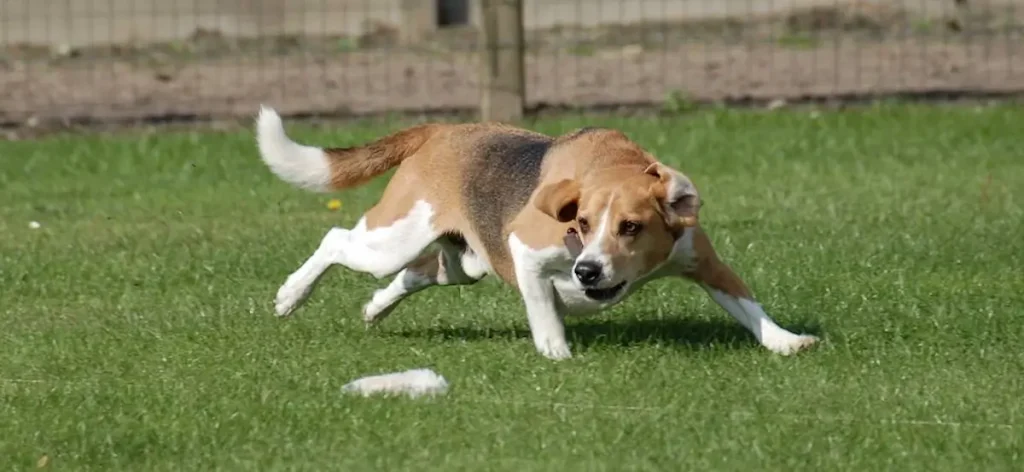Navigating the world of dog breeds can sometimes feel like getting lost in a labyrinth, but when you find yourself at the entrance to the Beagle’s world, you’ll discover a path worth following. You’ve likely seen their pleading eyes and heard the distinctive howl that can tug at a dog lover’s heartstrings.
As you consider bringing a Beagle into your life, you’re probably curious about their charming quirks, what makes them tick, and the exercise that keeps their tails wagging. Known for their merry personalities and boundless energy, these scent hounds pack a lot of spirit into a compact frame.
Before you leap into a commitment with this breed, it’s crucial to understand their unique characteristics and what it takes to ensure they lead a balanced and fulfilling life. Let’s embark on a journey through the ins and outs of Beagle ownership, where you’ll learn how this breed’s profile aligns with your lifestyle and how to cater to their physical needs – but keep in mind that there’s more to these dogs than meets the eye or, indeed, the nose.
- Noise Level
- Energy
- Sociability
- Trainability
- Care
- Health
Overall
Summary
The Beagle is a moderately noisy breed with a high energy level and excellent sociability. They are moderately trainable and require average care, while generally maintaining good health.
Beagle: Traits, Temperament, and Care Guide
The Beagle, a small to medium-sized breed renowned for its amiable nature and sharp intellect, requires consistent training and exercise to maintain its well-being. Your Beagle’s breed profile highlights a family-friendly temperament, ideal for those seeking a sociable companion.
Originally scent hounds, they thrive on hunting-driven activities. A comprehensive care guide emphasizes the importance of daily exercise to channel their active traits.
Exploring the Characteristics of the Beagle
Understanding your Beagle’s inherent characteristics is crucial for tailoring their care and exercise regimen to suit their energetic and inquisitive nature.
| Trait | Description | Relevance |
|---|---|---|
| Size | Small to medium, smooth coat | Easy to groom |
| Personality | Friendly, playful, intelligent | Make great family dogs |
| Origin | Bred to hunt | High energy, need daily |
| Exercise Needs | At least an hour of exercise daily | Prevents boredom |
| Sensory | Keen sense of smell, high prey drive | Tendency to bark |
Beagle: A Comprehensive Profile and Guide
As you consider bringing a Beagle into your home, it’s essential to understand their specific needs and traits.
These dogs possess a robust olfactory prowess, necessitating mental stimulation alongside their physical exercise regimen.
Be aware that while Beagles are inherently affable and compatible with children, their predisposition to vocalize can be challenging in condensed living spaces.
Everything You Need to Know About the Beagle
Diving into the comprehensive profile of Beagles, you’ll find they’re a breed characterized by their compact size, sharp intelligence, and an innate ability for tracking, making them an ideal companion for those who appreciate an active, yet manageable canine friend.
- Recognized by the American Kennel Club (AKC) for their friendly demeanor, ideal as family pets.
- Daily exercise needs to prevent boredom and combat potential separation anxiety.
- Prone to certain health problems; consult reputable breeders for health screenings.
- Require consistent training to harness their tracking prowess effectively.
Discovering the Temperament of Beagle
When considering a Beagle as a pet, it’s essential to recognize that their friendly and gentle disposition is balanced with a curious and often stubborn temperament, necessitating consistent training and ample exercise.
A beagle breeder will stress the importance of crate training and positive reinforcement to ensure they’re a good fit for active people. Properly trained, Beagles, with their pack-oriented hound nature, make great companions.

Beagle: Is It a Good Fit for Families?
Considering a Beagle as a family pet, you should be aware of their sociable nature, which often makes them a joy for children.
However, their propensity for stubbornness and potential for vocalization means consistent training and an adequate living space are crucial.
Balancing their exercise needs with your family’s lifestyle is essential to ensure a harmonious household.
Assessing Beagle’s Compatibility with Families and Kids
If you’re contemplating adding a beagle to your household, it’s essential to recognize that their amiable and even-tempered nature often makes them an excellent match for families with children.
- Recognized by the American Kennel Club, beagles make great family dogs due to their friendly demeanor.
- Bred for companionship, they get along well with kids, enhancing a sense of belonging.
- Their activity level fits well with active families.
- History notes Elizabeth I kept packs of Pocket Beagles, highlighting their good family dog lineage.
Beagle Adaptation Traits
Beagles often adapt well to various living situations. However, their high energy levels and vocal tendencies necessitate an environment where they can engage in regular physical activity and mental stimulation.
As a smart breed, Beagles thrive with consistent training that leverages their rabbit-hunting heritage. This helps them to utilize their intelligence effectively.
This medium-sized dog with a double coat requires regular grooming. Additionally, care for their floppy ears is essential to prevent conditions like hip dysplasia.
Beagles are known to be good with family, enriching the sense of belonging and making them a great addition to any household.
Beagle Obedience Essentials
To ensure your beagle’s obedience, you’ll need to prioritize positive reinforcement techniques, recognizing their quick-witted nature and scent-driven focus.
You must establish consistent leash training from an early age to manage their innate hunting impulses effectively.
Incorporating mental stimulation, such as puzzle toys and scent games, is crucial in curbing boredom-induced misbehavior in this active breed.
Effective Training Strategies
Harness the natural curiosity and energy of your Beagle by employing positive reinforcement and rewards, which are essential in mitigating their occasional stubbornness during obedience training. Proper training techniques are a good idea to prevent frequent barking, a common trait in the breed.
| Strategy | Benefit |
|---|---|
| Positive Reinforcement | Encourages good behavior without force |
| Scent-Based Activities | Utilizes Beagle’s strong sense of smell |
| Short Sessions | Keeps focus, prevents boredom |
| Leash Control | Essential for their rabbit-hunting instincts |
| Early Socialization | Promotes well-rounded behavior with others |
As a Beagle owner, you’re part of a community that understands the breed’s unique qualities, like their origin as packs of Pocket Beagles and their role as rabbit-hunting hounds. Be mindful of potential health issues and genetic diseases; staying informed helps ensure your Beagle’s well-being.
Beagle Exercise and Grooming Needs
Understanding the exercise and grooming requirements of Beagles is crucial. Their high energy levels demand regular activity, so daily paws should hit the pavement or roam a dog park to curb weight gain.
In addition to exercise, Beagles also require consistent care for their coat to maintain health and hygiene. A brushing routine is necessary to remove dead hair and maintain a sleek coat.
One distinctive feature of Beagles is their white-tipped tail, reminiscent of their origins in hunting in packs. This tail often weaves through interesting scents, showcasing their keen sense of smell.

Health Considerations for Beagle
As you explore the health considerations for Beagles, it’s crucial to be aware of common issues like hip dysplasia and epilepsy, which can impact their quality of life.
You’ll also need to monitor their weight closely, as obesity is a prevalent concern that can exacerbate other health conditions in this breed.
Regular veterinary visits and a stringent diet are imperative to maintain your Beagle’s health and extend their lifespan.
Common Health Issues and Lifespan
Monitoring the health of your Beagle is crucial, as they may be susceptible to conditions like hip dysplasia, epilepsy, and obesity, despite being a generally robust breed. As pet parents, understanding these common health issues is key to ensuring the longevity of your furry companion.
With a lifespan of 10 to 15 years, proactive Pet Health management is vital for Beagle-like dogs, maintaining the breed’s popularity even beyond hunting today.
Alternatives for Beagle: Lively and Curious Small Hounds
For those who love the Beagle’s lively and curious nature, these small hounds offer similar traits of enthusiasm and a strong scenting ability.
| Similar Dogs | Short Description |
|---|---|
| Basset Hound | Known for its incredible sense of smell and gentle, laid-back nature. |
| Dachshund | A playful breed with a unique body shape, known for its hunting and tracking skills. |
| Jack Russell Terrier | A small, energetic breed, excellent for hunting and full of character. |
| Harrier | Similar to the Beagle but larger, known for its stamina and friendliness. |
| American Foxhound | Known for its speed, stamina, and excellent scenting ability. |
Is Beagle the Right Pet for You?
Considering a Beagle as your future pet requires careful evaluation of their specific needs and personality traits to ensure they align with your lifestyle.
Reputable Beagle rescue groups can help determine if a puppy or adult dog would be the best fit for your family.
These good-natured dogs make great family pets, especially when properly socialized to get along with kids, but remember, their vivacity demands your commitment and understanding.
Conclusion
In the tapestry of canine companionship, the Beagle stands out with vibrant threads of joy and loyalty. Your journey with this breed promises a symphony of barks and boundless energy, requiring your steadfast commitment to their exercise and care.
Embrace the challenge of their spirited nature, and you’ll be rewarded with a fur-covered confidant, a beacon of affection in your family’s life. Consider all angles, and if your world aligns, a Beagle might just complete your perfect picture.
Frequently Asked Questions
What Kind of Exercise Do Beagles Need?
You’ll want to incorporate daily walks, agility training, and fetch sessions for physical activity. Scent games and nose work offer mental stimulation, while puzzle toys foster interactive play. Maintain exercise consistency with off-leash running.
What Is the Profile of a Beagle?
You’ll find the Beagle’s temperament friendly and their scent capabilities strong. They’re vocal, yet fit well with families. Training presents challenges; they’re sociable and live long. Health issues and feeding habits need attention before adoption.
What Are the Physical Characteristics of a Beagle?
You’ll notice beagles sport various colors, have distinctive floppy ears, and a size that’s small to medium. Their tail is usually raised, and the coat is smooth. Their expressive faces and muscular build are notable.
What Are the Properties of a Beagle?
You’ll find a Beagle’s temperament affectionate and compatible with family life. Their strong hunting instincts and remarkable scent capabilities are notable, as are their vocal tendencies. Intelligence makes training a challenge, yet it’s achievable with commitment.
